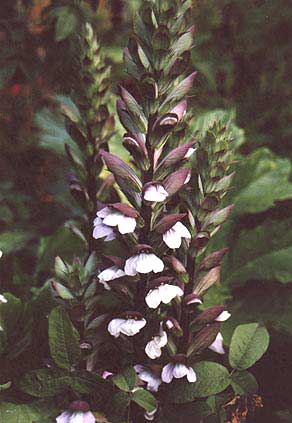Acanthus mollis
BEAR'S BREECHES
Family: Acanthaceae
Pronounced: ah-KAN-thus MAWL-iss
Quick Jumps
Growing Guide
Rainy Side Notes
GROWING GUIDE

Geographical origin:
Southwest Europe and Northwest Africa.
Plant group:
Perennial.
Hardiness:
Sunset zones: 5-24.
USDA zones: 7 -10.
Heat zones: 12-7.
Mature size:
Height: 5 feet (1.5 m).
Width: 36 inches (90 cm).
Flowering period:
Midsummer to late summer.
Flowering attributes:
White flowers are surrounded by purple calyces on three foot tall spikes.
Leaf attributes:
Deep green, deeply lobed, shiny leaves, some up to three feet long.
Growth habit:
Clump-forming.
Light:
Full sun or partial shade.
Soil:
Humus rich, moist, well-drained soil.
Feeding:
Side dress with compost or manure. Fertilize monthly, spring through early summer with a complete organic fertilizer.
Propagation methods:
Sow seed in spring and place in a cold frame or in situ as soon as seed is ripe. Germinates in 3 — 4 weeks at 50°F (10°C). | Divide in spring or fall. | Root cuttings late fall or early winter.
Rainy Side Notes
Acanthus mollis is a big and bold plant. It has some of the finest foliage in the plant kingdom. The leaves have been inspiration for many important decorative Western art and architectural designs.
In hot summer areas, A. mollis dies back to the ground during summer only to return when the weather cools off. Here in the Pacific Northwest, with our cool climate, the plant does not go dormant during the summer. With milder winters, the leaves stay present through most of the year.
I transplanted this plant from another garden to its present location. It sat there for five years while I patiently waited for it to bloom. I planted a new variety–Acanthus 'Summer Beauty' one year and it bloomed the following year. I threatened A. mollis with shovel pruning it if it didn't bloom that year. Thankfully, it bloomed, and I didn't have to carry out my threat. Sigh, what a gardener has to do to get some plants to bloom. I finally see it was worth the wait to enjoy this plant in full bloom.
Photographed in author's garden.

Gardening for the Homebrewer: Grow and Process Plants for Making Beer, Wine, Gruit, Cider, Perry, and More
By co-authors Debbie Teashon (Rainy Side Gardeners) and Wendy Tweton
Copyright Notice | Home | Search | Perennials

